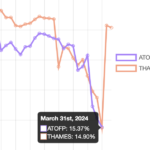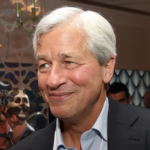In 2015, size equalled success in the stock market. But did benchmarking make this a self-fulfilling prophecy? Let’s start by looking at the market capitalisation of S&P 500 companies at the end of the year, with colours according to price change.

This is an index weighted by market cap and the dominance of the biggest companies is striking. The 50 biggest constituents make up almost half of the S&P’s total value. If you invest in a fund that tracks this index you are making an implicit bet on size. Putting it another way, you might be overestimating the diversification benefits of the remaining companies in the index.
One way to express this is by building a portfolio starting with the most valuable company and to keep adding stocks weighted by market cap until you are invested in the entire index. The cumulative value of this portfolio traces out a curve (called a Lorenz curve) as stocks are added, which you can compare with the straight line you get when creating an equally-weighted portfolio of S&P stocks. The ratio of the area between the curve and the line and the area below the line is called the Gini coefficient1)I first learned about this approach from the quant Thierry Roncalli who submitted a paper that I published in the Bloomberg risk newsletter in 2011.
Used to measure income or wealth inequality, the Gini coefficient here measures the dominance of large-cap stocks in the index. For the S&P 500, the coefficient is about 60 per cent, similar to Italy in wealth inequality terms. This doesn’t seem that high until you remember that the S&P is already a selection of big companies. Extending the list to the broader-based Russell 3000 index produces a Gini coefficient of 81 per cent, roughly the same as wealth inequality for the US as a whole.

Of course, the stock market index is not a country, it’s a collection of companies that compete in the market for capital. You might argue that any imbalance in their sizes is just the market doing its job. Then again, the wealth of the richest people is often bound up in the stock of companies they run, so if you are bothered by wealth inequality, then market cap inequality should bother you too.
Even for investors indifferent to wealth imbalances, this has important consequences because of the trillions of dollars in funds that track the index or benchmark themselves against it.
And this takes me back to 2015. If you tracked the S&P500 as a whole, you would have lost 0.7% during the year (not taking dividends into account). It turns out that if you restricted your investment to just a handful of stocks, you would have done better. Here I am not talking about winning bets that with benefit of hindsight should have been made at the start of the year, such as Amazon or Facebook, or a short position in energy stocks.
No, this is just blind investing in the biggest members of the index, in the same way as the Gini coefficient portfolio was constructed above (the difference being that I now use the ranking by market capitalisation at the start of 2015). How many stocks does it take to get the best performance? If you put all your money in Apple you would have lost 4.6%. If you added the second-ranked stock, Exxon Mobil, your loss in price terms would have increased to nearly 9%. But then things improve. By the time you add your fifth stock, Google, your return is a positive 5%.

But that’s as good as it gets. Keep adding cap-weighted stocks to your portfolio, and returns drift downwards. By the time you have 40 stocks, it stays negative and no further addition of S&P members improves things2)Because the S&P500 index adjusts market cap weights for free float, the aggregate return doesn’t converge to the S&P500 price return itself. To reiterate, there is no foresight in this strategy. If anything it amounts to a form of momentum investing because it rewards stocks that performed well in the preceding year.
What conclusions can we reach from this analysis? First, it shows how quickly diversification happens when portfolios are weighted by market cap. It suggests that tracking the entire index is probably a wasted effort. Secondly, we see the impact that such weighting rules have. They amount to bets that are as significant as any decision an active manager will make for you.
Finally, it’s a reminder that index benchmarking makes wealth imbalances a self-fulfilling prophecy. A circular winner-takes-all process takes place: the wealth of Jeff Bezos or Mark Zuckerberg attracts funds that automatically causes their wealth to increase. It will be interesting to see how this effect plays out in 2016.
References
| 1. | ↑ | I first learned about this approach from the quant Thierry Roncalli who submitted a paper that I published in the Bloomberg risk newsletter in 2011 |
| 2. | ↑ | Because the S&P500 index adjusts market cap weights for free float, the aggregate return doesn’t converge to the S&P500 price return itself |
Comments are closed.
 Levelling the Playing Field
Levelling the Playing Field
 Barclays and Labour's growth plan
Barclays and Labour's growth plan
 Plummeting bonds reflect souring UK mood for outsourcing and privatisation
Plummeting bonds reflect souring UK mood for outsourcing and privatisation
 Dimon rolls trading dice with excess capital
Dimon rolls trading dice with excess capital
why do you show netflix down 66% for the year? it more than doubled as far as i know!
Fixed. Thanks for spotting.
Could this be repeated for earlier years to see if a particular pattern plays out? Would be interesting to see whether this is a one-off.
I will look into this when I have some time.
Nick — are some of the price changes in your heat map awry? Netflix didn’t fall 66% last year; Visa did not drop 70%….
Thanks for pointing this out. I was using an unadjusted price feed which is now fixed.
Visa was up 14% last year, not down 70%! You need to adjust for the 4:1 stock split.
Also looks like Visa is not correct. It wasn’t down 70% for the year. Very interesting article!
You also show Visa down for the year, when it was up.
Thank you Sir. Very interesting insight Nick. Blue chips of blue chips seem to be winners here. A lot of people played safe last year. I presume that financials can regain in the this year.
so passive index investing is effectively betting on the momentum factor. more investments are going from active to passive. and the largest amount of money goes to the largest company – so if the market cap increases a bit by the active fund managers, then the passive indices will take care of it keeping it buoyant and bringing in more buyers